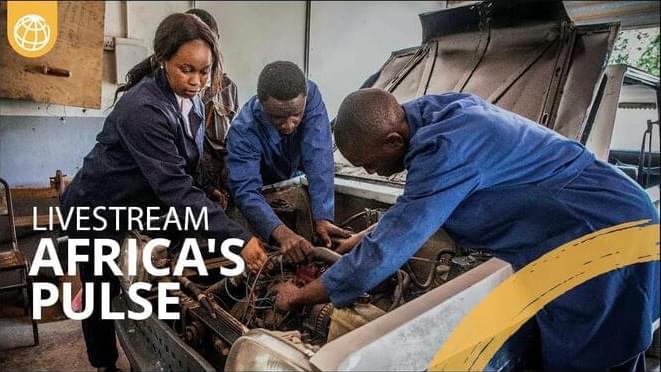Africa’s Pulse is a biannual publication containing an analysis of the near-term macroeconomic outlook for the region. Each issue also includes a section focusing upon a topic that represents a particular development challenge for the continent.

Africa’s Pulse is a biannual publication containing an analysis of the near-term macroeconomic outlook for the region. Each issue also includes a section focusing upon a topic that represents a particular development challenge for the continent.
All lawyers, from in-house counsel and law firms, to barristers and judges, need to embrace the use of generative artificial intelligence (AI). Why? Because it will become an indispensable productivity tool across the legal profession.
Neuron al behavior can be controlled by probing and modulating subcellular regions of the cells; however, developing an interface that can morph into the extreme curvatures of neurites is a major challenge. Here, the authors develop a wireless platform made of an azobenzene polymer that undergoes on-demand light-induced folding with an ultra-low curvature radius and wraps various morphologies of neuronal processes in vitro.
Live Appearances: Worcester & Newark!
Expand your universe with astrophysicist, professor and New York Times best-selling author Neil deGrasse Tyson. In this thought-provoking talk, he’ll discuss the anatomy of science and the scientific process. What exactly is science? How does it work? And why is it so effective at explaining the confusing world around us? Learn how science can help humanity answer our most pressing questions — and why the future of our species depends on it.
NJPAC’s Conversations Series is graciously supported by the Blanche and Irving Laurie Foundation.
A new drug strategy that regulates the tumor immune microenvironment may transform a tumor that resists immunotherapy into a susceptible one, according to a study by researchers from the Johns Hopkins Kimmel Cancer Center and Oregon Health & Science University.
The immune microenvironment around a pancreatic tumor has suppressed immune activity, allowing the tumor to evade attacks by the immune system. The cancer evades the immune system by attracting suppressive cells into the tumor, which limits access of tumor-killing T cells. Because of that so-called immune desert environment, pancreatic ductal adenocarcinoma (PDA), the most common type of pancreatic cancer, has been resistant to immune-based therapies that have successfully treated a variety of other cancers, including melanoma and lung cancer.
In a phase 2 clinical trial, a research team led by Nilofer Azad, M.D., professor of oncology and co-leader of the Kimmel Cancer Center’s Cancer Genetics and Epigenetics Program, and Marina Baretti, M.D., the Jiasheng Chair in Hepato-Biliary Cancer at the Kimmel Cancer Center, tested the safety and efficacy of the combination of two drugs: an immunotherapy, nivolumab, and an epigenetic drug, entinostat — a histone deacetylase inhibitor (HDACi). The combination was studied in a group of 27 patients with advanced PDA who had previously been treated with chemotherapy.
A research team led by Lund University in Sweden has developed an AI tool that traces back the most recent places you have been to.
Microorganisms are organisms, such as bacteria, that are invisible to the naked eye. The word microbiome is used to describe all the microorganisms in a particular environment. Establishing the geographical source of a microbiome sample has been a considerable challenge up to now.
However, in a new study, published in the research journal Genome Biology and Evolution, a research team presents the tool Microbiome Geographic Population Structure (mGPS). It is a unique instrument that uses ground-breaking AI technology to localise samples to specific bodies or water, countries and cities. The researchers discovered that many places have unique bacteria populations, so when you touch a handrail at a train station or bus stop, you pick up bacteria that can then be used to link you back to the exact place.
Continue reading “New GPS system for microorganisms could revolutionise police work” »
“I can say with certainty that brains work on completely different principles than deep learning, and these differences matter.” writes Jeff Hawkins in a new essay.
Excerpt:
Why should we care about how the brain works?
Continue reading “For truly intelligent AI, we need to mimic the brain’s sensorimotor principles” »
Summary: Researchers have discovered that the NMDA receptor (NMDAR), known for its role in learning and memory, also stabilizes brain activity by setting baseline neural network activity. This stabilization supports the brain’s adaptability amid constant environmental and physiological changes.
The study revealed that blocking NMDARs disrupted this baseline, highlighting their critical role in maintaining neural homeostasis. Findings may revolutionize treatments for conditions like depression, Alzheimer’s, and epilepsy by leveraging NMDAR’s role in brain stability.
Summary: A deep learning AI model developed by researchers significantly accelerates the detection of pathology in animal and human tissue images, surpassing human accuracy in some cases. This AI, trained on high-resolution images from past studies, quickly identifies signs of diseases like cancer that typically take hours for pathologists to detect.
By analyzing gigapixel images with advanced neural networks, the model achieves results in weeks instead of months, revolutionizing research and diagnostic processes. The tool is already aiding disease research in animals and holds transformative potential for human medical diagnostics, particularly for cancer and gene-related illnesses.
The multiverse offers no escape from our reality—which might be a very good thing.
As memes go, it wasn’t particularly viral. But for a couple of hours on the morning of November 6, the term “darkest timeline” trended in Google searches, and several physicists posted musings on social media about whether we were actually in it. All the probabilities expressed in opinion polls and prediction markets had collapsed into a single definite outcome, and history went from “what might be” to “that just happened.” The two sides in this hyperpolarized U.S. presidential election had agreed on practically nothing—save for their shared belief that its outcome would be a fateful choice between two diverging trajectories for our world.
